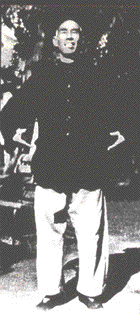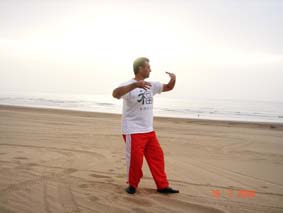VISIT OUR NEW WEBSITE : WWW.YIQUAN.FR
NATIONAL ACADEMY OF KUNG FU WUSHU - YI QUAN
HISTORY OF YI QUAN
NATIONAL ACADEMY OF KUNG FU WUSHU - YI QUAN
HISTORY OF YI QUAN
ROOTS OF YI QUAN :
During centuries, the art of Kung
Fu remains the same and it is only in the middle of the 19th century
that it changes under the impulse of Kuo Yun Seng.
Kuo Yun Seng was called " the Divine Palm ", and he
was the greatest expert of his time in Xing Yi Quan (the boxing
of the unit of the body and the thought : Xing = form, Yi = will,
thought, Quan = fist, boxing, or in its original significance
" to do instantaneously what the heart decides ").
He insists on the postures and simplifies the form of the Tao Lu, then
transmits his art to Wang Xian Zhaï, his preferred disciple.
HISTORY OF MASTER WANG XIAN ZHAÏ, CREATOR OF YI QUAN :

1885 :
Master Wang Xian Zhaï was born in 1885 in the Hebei province.
At the end of the 19th century, in China, Master Wang Xian Zhai had
observed that the Chinese society changed. The profit, base of a modern
mode of production, revolutionized the relationship between the men.
The martial arts, component of this same society, had them also
tendency to lose their essence. The practice of the fast movements,
therefore badly controlled, the exaggeration of the importance of the
muscular force and hardening with excess of the body, often with a
conclusive aim, characterized the majority of the practise. He then
decided to return to the sources of Kung Fu, at a time when one could
control " the movements of the immobility ", immobility which is the "
mother " of any movement.
1913 :
In 1913 he was engaged as instructor with the army.
1918 :
In 1918 he crosses China from North to the South, he observes
and learns the essence of other styles which include techniques
of fists and legs. He also makes a stay at the monastery of Shaolin
where he is involved in particular with the higher bonze, expert
in Xin Yi Quan. (Xin = the heart)
This assiduous study helps him to discover what he seeks : control
of the speed and the force by the concentration, the relaxation,
and the slow movement, thus restoring a true return to the sources
of art. Until the 12th century indeed, the practice of Kung Fu
passed by the mobilization of the thought, the control of the
posture and the slow movement, to reach the explosive force. The
method used named Zhan Zhuang, which means " to remain upright
such as a tree or a pile ".
The two experts find themselves perfectly in their mutual search. They
share their techniques to supplement their work.
1925 :
In 1925, Master Wang Xian Zhai declares that " the practise
in general neglect the importance of the thought in the movement
". He creates Yi Quan
in
which you find the linear work of Xing Yi, circular displacements
of Bagua, the principle of " sticking and following "
of Taïji and the essence of other styles such as the essence
of the school of Shaolin, etc...
He preaches a martial arts serving health while proving to be
a method of effective combat.
It was a new way of considering the martial arts because of the absence
of forms (Tao-Lu), the most significant being the concentration, the
will.
1940 :
In 1940, the colleagues of Master Wang in Beijing recognize the
value of his art and give it the name of Da Cheng Quan.
The term Da Cheng means great success, achievement, perfection.
Da Cheng Quan thus means the great achievement of the harmony
of the body and the spirit.
Later, Master Wang, always modest and conscious that one never
reaches the great achievement in Wushu, returns definitively to
the name Yi Quan.
It is just today to respect this desire.
From the beginning of the Fifties, he teaches Zhan
Zhuang Gong (position of the pile or position of rooting) in
various medical institutes.
1963 :
Master Wang Xian Zhaï died in Tien Tsin.
THE THOUGHT OF THE CREATOR OF YI QUAN :
SUCCESSION OF MASTER WANG XIAN ZHAI :
MASTER YAO ZONG XUN (1917-1985)

The best pupil of Master Wang
were Zhao Dao Xin, installed in Tiantsin where he created his
own method and have practically not left any pupil, You Peng Xi,
from Shanghai, which has make in the same way and the one which
will become his successor, Yao Zong Xun from Beijing.

Until 1985, year of Master Yao
Zong Xun's death, everyone, including Wang Xian Zhai's daughter,
which she reports in her book, recognizes Master Yao Zong Xun
as the successor of Wang. He is the last who has made the Yi Quan
school evolve and at the same time the most gifted and the most
honest of the three.
Very young, Yao Zong Xun begins the study with Wang Xian Zhaï
who considers him as his son. In 1940, Wang names him his successor
and gives him the nickname Ji Xiang (the successor of Xian) and
symbolically offers him a demonstration costume. From this day,
Yao Zong Xun has replaced Wang when this one misses, taking up
the challenges and teaching.
Yao Zong Xun was an expert of a very open spirit ; he knew the
techniques of the other schools, therefore he always took the
best of each style to include it in his practice of Yi Quan.
He said to his pupils: " Learn Yi Quan ; if you have other valid
techniques, keep them, but apply them through the principles of Yi Quan
". He also taught his pupils the totality of his knowledge without
mysticism nor superstition.
Master Yao Zong Xun died in 1985,
leaving his two sons and good students.

YI QUAN TODAY :
Different schools developp themselves,
especially in Beijing's area.
In Japan, Yi Quan is known by the Taï Ki Ken students. Taï
Ki Ken was created by Master Kenichi Sawaï, former student
of Wang Xiang Zhaï, but who mainly studied under the direction
of Yao Zong Xun.
Yi Quan schools exist in France, Italy,
Argentina, Great-Britain, Portugal, Singapore and Hong-Kong.
In Europe, Yi Quan was introduced
by Ilias
Calimintzos, only
Westerner which was initiated by Master Yao Zong Xun.

Master Yao Zong Xun and Ilias
Calimintzos

The School
of Master Yao is still united.
From left to right : Yao Cheng Rong, Ilias Calimintzos, Yao Cheng Kwang
and Cui Rui Bin



Ilias CALIMINTZOS during a seminar in Marocco, 2004